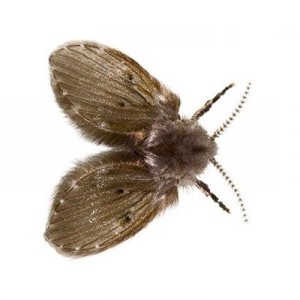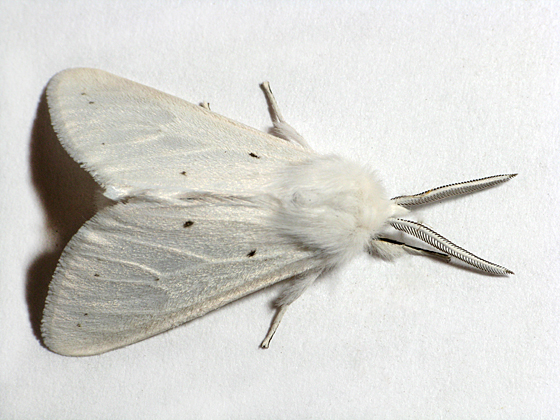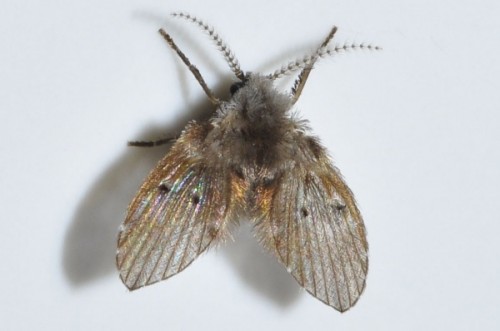
Table of Contents
1. Overview
Fun fact #1: This species is also known as moth fly. Upon closer look, it does resemble a moth!Figure 2. Comparison of moth fly (left) and a moth (right). Left photo by Poulin's Pest Control (permission pending). Right photo by Ashley Bradford licensed under Creative Commons License.
The bathroom fly [1] (Clogmia albipunctata) (Williston, 1893) also commonly known as the drain fly, filter fly or sewage fly is most commonly found in under used bathrooms all over the world. Just like other urban flies, the bathroom fly is considered a nuisance and may cause certain health problems [2] .
2. Pest control
Fun fact #2: Caffeine causes high death rate in bathroom fly and disrupts the development of their brain and sex organs [3] . Good news for coffee lovers!If you have been away on vacation or haven’t used a bathroom in while, you may get freaked out when you see a swarm of tiny flies on your bathroom walls. They are likely to be bathroom flies if,
- they are grey in colour,
- they have a very small, hairy body slightly smaller than a grain of rice,
- they are bad at flying, appearing to be hopping instead [4] .
Video 1. Drain Fly Control and Treatment by Do It Yourself Pest Control. Obtained from YouTube under fair use.
Usually, a bathroom fly problem will go away on its own once you start to use the bathroom frequently. After removing the drain flies that you see, be it drowning them or swatting them, start flushing toilets and running water in your sinks. This removes stagnant water where their larvae lives [5] .
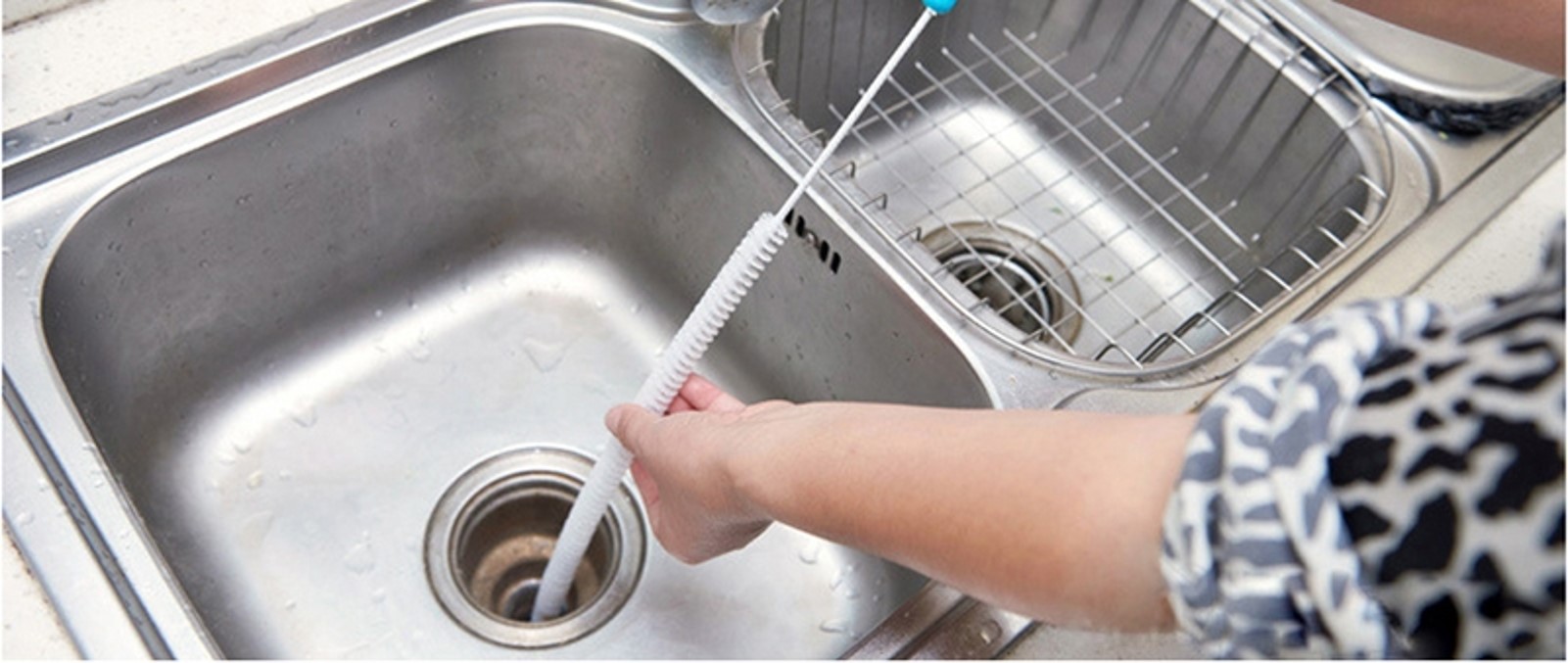
To prevent future infestations:
- Clear the sludge that have accumulated in the sewer regularly. This removes the feeding and breeding site.
- Make sure that there are no stagnant water and keep the bathroom as dry as possible.
However, because of their size, these flies can easily pass through the drainage covers, small cracks and openings and land on your bathroom. If your drain fly problem persists for more than two weeks, this may be due to a breeding site outside of your home. In that case, seek the help of professional pest controllers [6] .
2.1 Human Health
Fun fact #3: Hairs of bathroom flies are different from ours! They help the fly sense the environment and resists water.Bathroom flies have been known to be opportunistic agents of myiasis, a condition where the larvae develop inside the bodies of mammals. They can enter the human body via the urinary, nasal and intestinal tract [7] [8] [9] [10] . However, these cases are rare as bathroom flies do not have a preference or need to develop in a host. Usually, myiasis is caused by accidental ingestions of eggs or early-stage larvae in contaminated food [11] .
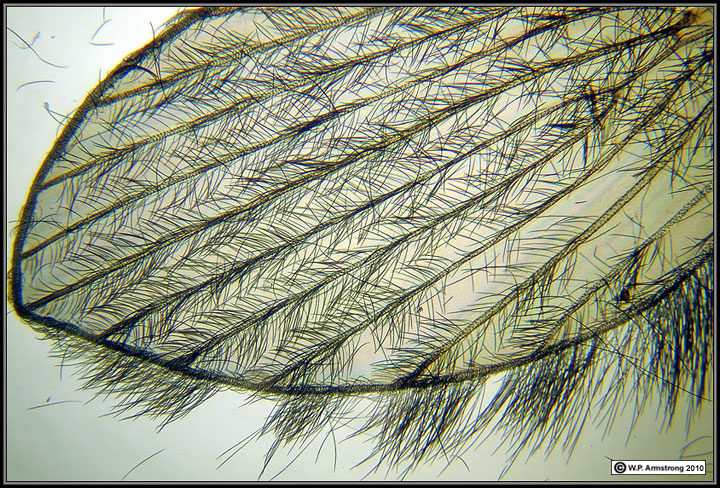
When the hairs of these flies are inhaled due to over-infestations indoors, respiratory problems may occur [12] . Also, hairs on the bathroom flies increases its surface area and may be contaminated with bacteria when they move through the sewage, which can infect humans upon contact [13] .
3. Natural History and Biology
Watch the video below for an interesting description of the bathroom fly by a YouTube user.Video 2. Description of bathroom flies by Eric Hufschmid. Obtained from YouTube under fair use.
3.1 Habitat
The natural habitat of bathroom fly is in mangroves where the larvae can thrive on aquatic, semi-aquatic habitats, decaying matter and many microhabitats of the forest floor [14] . With rapid urbanisation throughout the world, urban habitats similar to mangroves forests floor such as sewage systems provide opportunities for them to thrive in [15] .3.2 Global Distribution
This species is originally distributed in the tropics [16] but is widespread throughout the world [17] [18] [19] , due to export of contaminated fruits and vegetables in the 1990s [20] .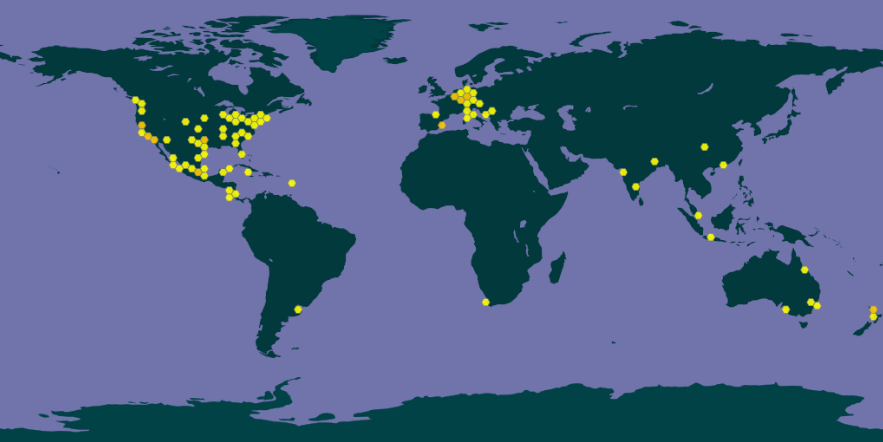
Singapore being a city with high rise buildings and vast sewage systems is an ideal habitat for the bathroom fly. They are commonly found in public toilets of MRT and petrol stations.
3.4. Life Cycle
Fun fact #4: Adult flies survived for about 12 days and therefore you may want to contact a professional if your bathroom fly problem persists for more than 2 weeks. Not so fun after all!Before mating, the female needs to be impressed by the dance moves of the male. Watch the video to learn some impressive dance moves!
Video 3. Mating behaviour of bathroom flies by Roger Pratt. Obtained from YouTube under fair use.
As with other flies, bathroom flies undergo complete metamorphosis with egg, larval, pupal and adult stages [22] . The life cycle starts when female lay eggs in moist organic matter and ends at the adult stage. Eggs hatch in about 3 days. Larvae are divided into 4 stages and last for about 18 days before pupation. Adults emerge about 5 days after pupation, mates immediately and lay eggs about 3 days later. A total of about 27 days is required for the life cycle to complete [23] . Depending on conditions such as temperature and humidity, the time taken for the life cycle to complete may vary [24] .
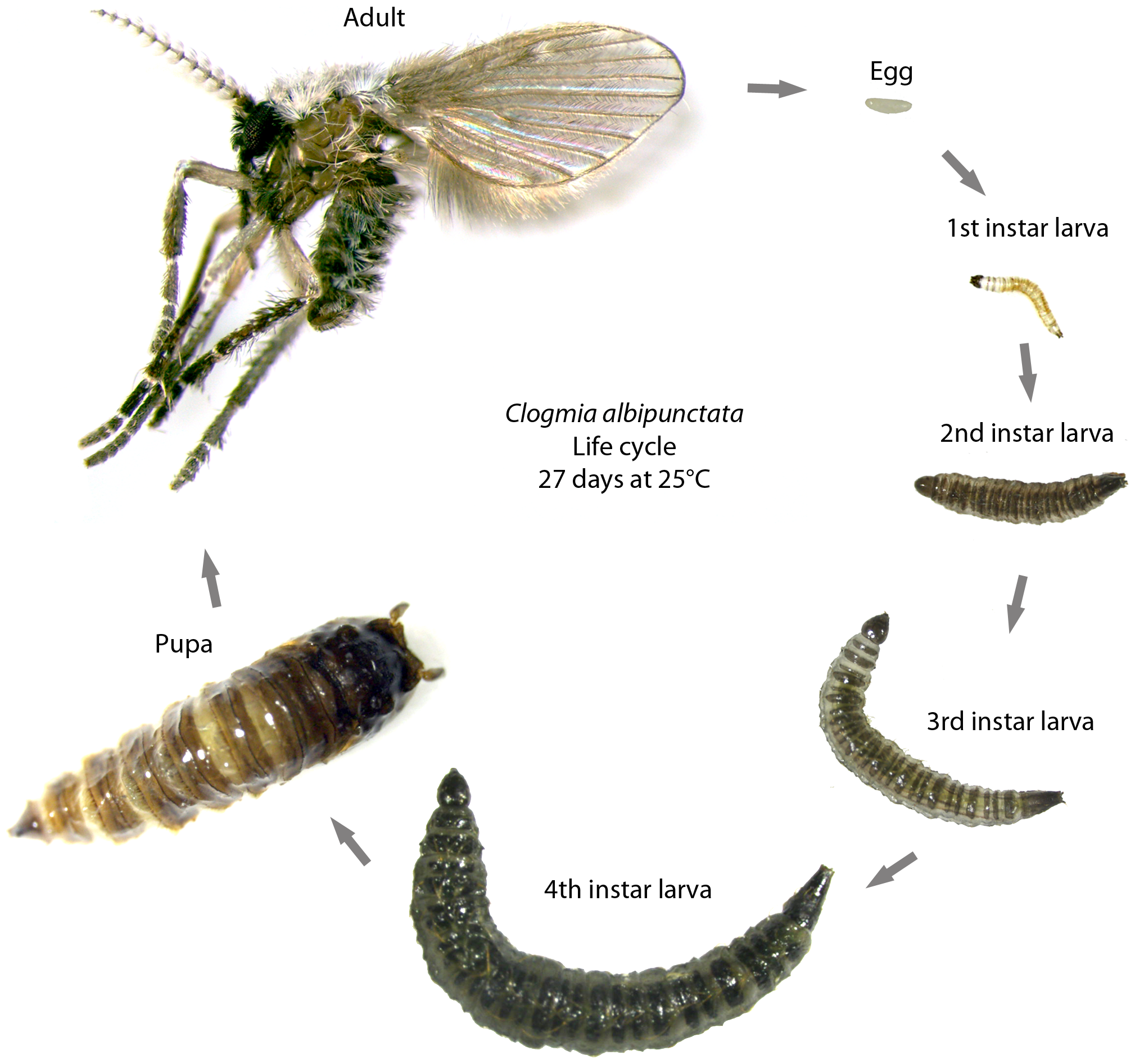
3.5. Diet
Just like typical flies, the bathroom flies feed on different food sources at different stages. Larvae feed on a bacterial slime of decaying organic matter often built up in the plumbing of drains. This may be beneficial to prevent clogging of pipes and drains [25] . Alternatively, the larvae can feed on piles of wet leaves of other organic materials. Pupae do not feed. Adults feed on nectar and other liquid sugars which means they do not bite humans for food nor require blood for producing eggs [26] .4. Taxonomy and Systematics
4.1. Classification
Learning time!: Classifying living things is important for the understanding and scientific study of life. Living things are classified based on similar characteristics that are shared among one another. For more information on how living things are classified, click here.Class: Insecta
Order: Diptera
Suborder: Nematocera
Family: Psychodidae
Subfamily: Psychodinae
Genus: //Clogmia// Enderlein, 1937
The above classification is adapted from the Universal Protein Resource (UniProt).
4.2. Synonyms
Learning time!: Have you ever wondered how a species is name? Naming a species is a complicated business and scientists have created a code dedicated for this. Just like how laws are passed to determine what are lawful conducts or misconducts in a country, International Code of Zoological Nomenclature determines the correct way that a species should be named.“I am known by many names, but you may call me...Tim.”
― Graham Chapman from Monty Python and the Holy Grail
Many synonyms are attributed to this species due to the complexity of the taxonomic history of its family Psychodidae[2]. The genus Clogmia was considered to be synonym for Telmatoscopus for a long time while many other independent descriptions of this species resulted to many less common synonyms[2].
Psychoda albipunctata (Williston, 1893) (Original description)
Telmatoscopus meridionalis (Eaton, 1894)
Psychoda snowii (Haseman, 1907)
Psychoda albonigra (Brunetti, 1908)
Telmatoscopus albipunctatus (Tonnoir, 1921)
Psychoda erecta (Curran, 1926)
Clogmia albipunctata (Enderlain, 1937)
Telmatoscopus albipunctatus (Vaillant, 1972)
While most medical literature still refer to this species as Telmatoscopus albipunctatus, Clogmia albipunctata is considered the valid name by most taxonomists [27] .
4.3. Type Information
Learning time!: A type species may not be representative of the genus. Just like how apple does not represent fruits, bathroom fly does not represent the genus Clogmia. To learn more about how a type species is designated, visit the International Code of Zoological Nomenclature website.Type locality: Havana, Cuba
Kind of type: Lectotype
Depository of type: National Museum of Natural History, Washington, D.C., United States of America [28]
Psychoda albipunctata Williston, 1893, now regarded as a synonym of Clogmia albipunctata, is the type species for the genus Clogmia[3].
4.4. Phylogeny
Learning time!: Scientists learn how species are related to one another by creating phylogenies. Just like how you and your cousin is related based on common ancestry (grandparents), all life forms are related to one another evolutionarily based on common ancestry. Click here to watch a video explanation of the tree of life by David Attenborough.The bathroom fly belongs to the family Psychodidae and the phylogenetic relationships of this family is controversial as different studies have established different phylogenies for this family [29] .
A recent study conducted by Jiménez-Guri et al. suggests that Psychodomorpha (taxon that includes Psychodidae) is sister group to Branchycera and thus, not a sister group with Neodiptera. This is in contrast with a previous study conducted by Wiegmann et al. which concluded that Psychodidae is a sister group to Neodiptera and this divergence happened around 250 million years ago [30] .
By comparing the methods of both study, we can safely conclude that the phylogeny established by Jiménez-Guri et al. may be more accurate because more data were considered when establishing the character matrix and nuclear genes were used. The study conducted by Jiménez-Guri et al. uses a more advanced method (phylome reconstruction [31] , where whole genomes of species are used as the seed) which, in this case, compares 160 genes that were further analysed using maximum likelihood [32] (bootstrap support = 91%). On the other hand, Wiegmann et al. used a nucleotide set consisting of 12 nuclear protein-coding genes, 18S and 28S ribosomal DNA, and complete mitochondrial genomes (bootstrap support = 95%). Even though the bootstrap support is higher, the relatively fewer characters being considered in Wiegmann et al. study as compared to Jiménez-Guri et al. calls for doubt on the phylogeny created (imagine comparing your relationship with a stranger using the character eye colour only as compared to more characters being used, which will be more accurate?).
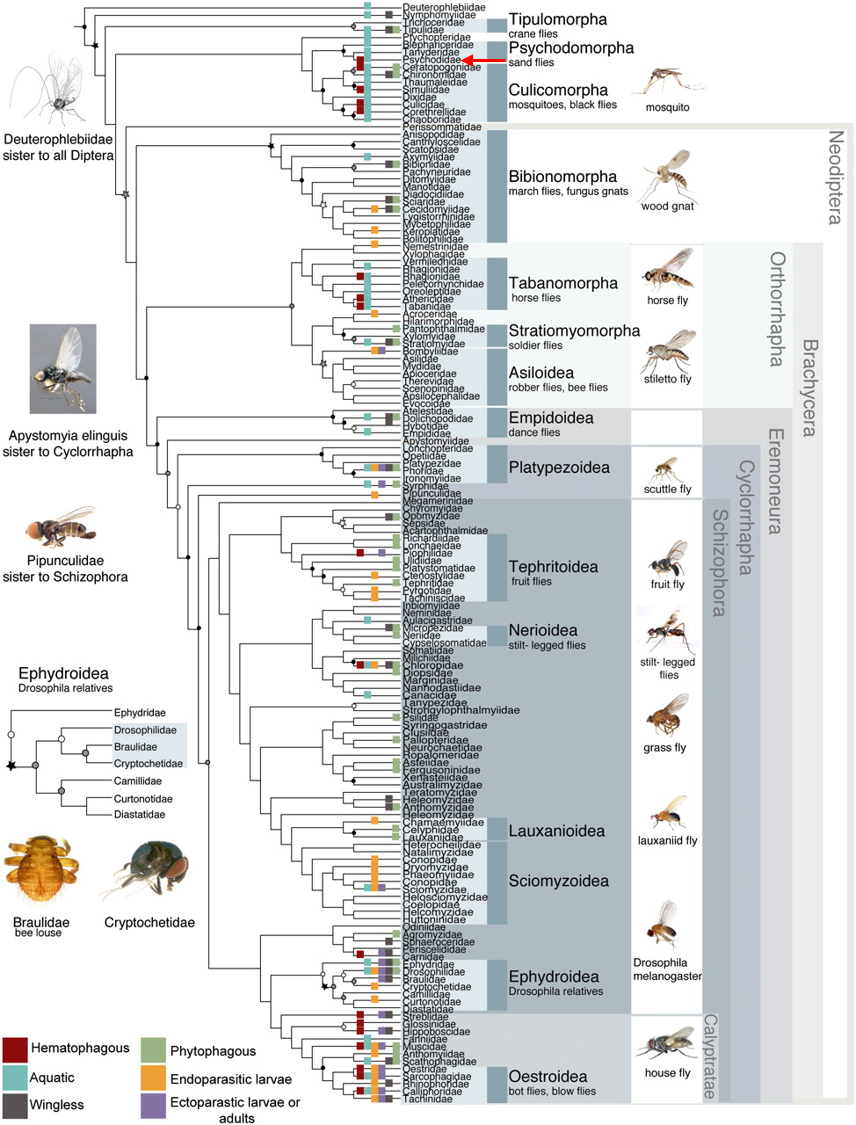
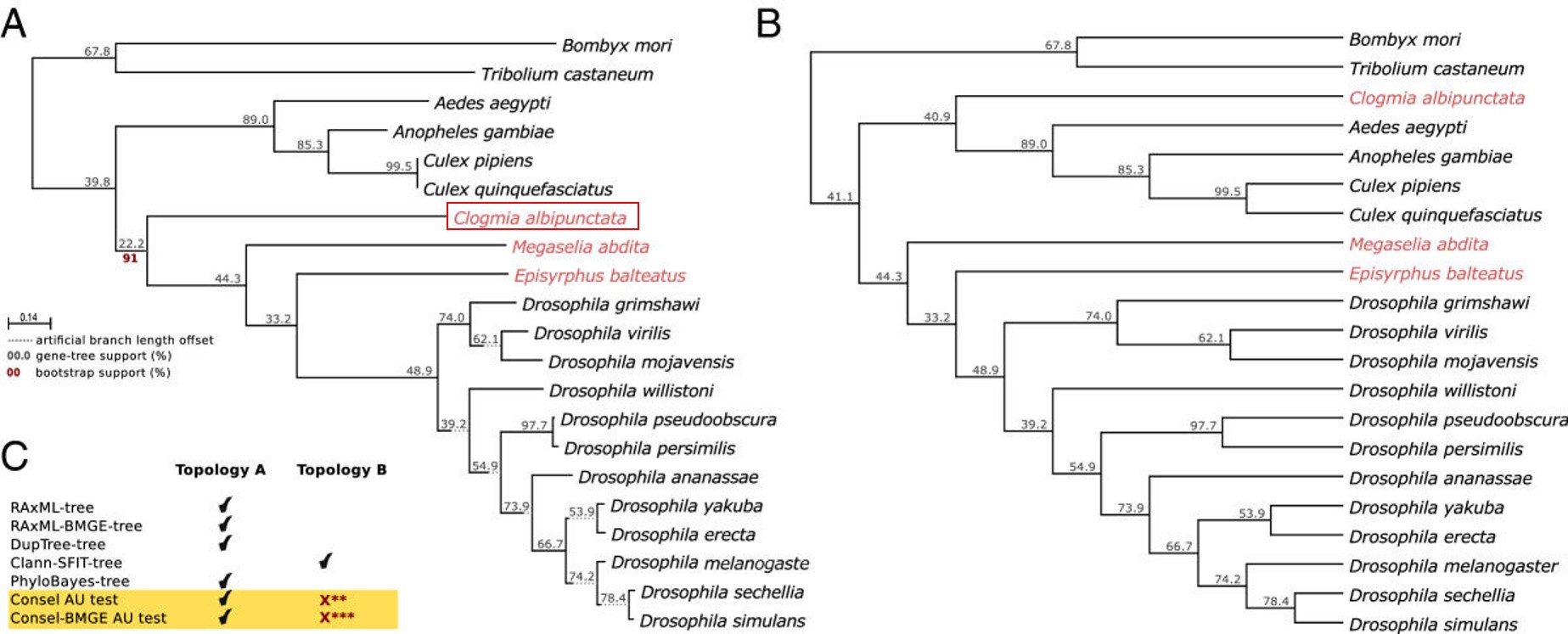
Boumans, L., Zimmer, J. Y., & Verheggen, F., 2009. First records of the'bathroom mothmidge'Clogmia albipunctata, a conspicuous element of the Belgian fauna that went unnoticed (Diptera: Psychodidae). Phegea, 37(4): 153–160.
Sehgal, S. S., Simöes, L. C. G. and Jurand, A., 1977. Effects of caffeine on growth and metamorphosis of moth fly Telmatoscopus Albipunctatus (Diptera: Psychodidae). Entomologia experimentalis et Applicata, 21(2): 174–181.
"Drain Flies or Moth Flies," by Townsend, L. Entomology at the University of Kentucky., July 2007. URL: https://entomology.ca.uky.edu/ef615 (accessed on 14 Nov 2017).
“How To Get Rid Of Drain Flies,” by Anonymous. Do It Yourself Pest Control., June 2017. (accessed on 14 Nov 2017)
Nevill, E. M., Basson, P. A., Schroonraad, J. H., & Swanepoel, K. A., 1970. A case of nasal myiasis caused by the larvae of Telmatoscopus albipunctatus (Williston) 1893 (Diptera: Psychodidae). Tropical Diseases Bulletin, 67(4): 512–514.
Tu, W. C., Chen, H. C., Chen, K. M., Tang, L. C., & Lai, S. C., 2007. Intestinal myiasis caused by larvae of Telmatoscopus albipunctatus in a Taiwanese man. Journal of clinical gastroenterology, 41(4): 400–402.
Faulde, M., & Spiesberger, M., 2012. Hospital infestations by the moth fly, Clogmia albipunctata (Diptera: Psychodinae), in Germany. Journal of Hospital Infection, 81(2), 134–136.
Glime, J. M., 2017. Terrestrial Insects: Holometabola – Diptera Overview. Chapt. 12-17. In: Glime, J. M. Bryophyte Ecology. 1 Volume 2. Bryological Interaction.
Vaillant, F., 1972. Psychodidae in Lindner E.(ed.): Die Fliegen der palaearktischen Region. Stuttgart, 291: 49–78.
“Moth or Drain Flies,” by Theuret, D. and Gerry, A. University of California Statewide IPM Program, Mar 2014. URL: http://ipm.ucanr.edu/PMG/PESTNOTES/pn74167.html(accessed on 14 Nov 2017).
Marshall, S. F., 2012. Flies – The Natural History and Diversity of Diptera. Firefly books Ltd, Buffalo, NY, USA.
Wagner, R., 2004. Fauna Europaea: Psychodidae. Fauna Europaea Web Service version, 2(2).
Quate, L. W., 1955. A Revision of the Psychodidae (Diptera) in America North of Mexico. University of California Press, 10: 103–273.
Yeates, D. K. and Wiegmann, B. M., 1999. Congruence and controversy: toward a higher-level phylogeny of Diptera. Annual review of entomology, 44(1): 397–428.
Wiegmann, B. M., Trautwein, M. D., Winkler, I. S., Barr, N. B., Kim, J. W., Lambkin, C., Bertone, M. A., Cassel, B. K., Bayless, K. M., Heimberg, A. M. and Wheeler, B. M., 2011. Episodic radiations in the fly tree of life. Proceedings of the National Academy of Sciences, 108(14): 5690–5695.
Huerta-Cepas, J., Capella-Gutierrez, S., Pryszcz, L. P., Denisov, I., Kormes, D., Marcet-Houben, M. and Gabaldón, T., 2010. PhylomeDB v3.0: an expanding repository of genome-wide collections of trees, alignments and phylogeny-based orthology and paralogy predictions. Nucleic acids research, 39(suppl_1): D556–D560.
